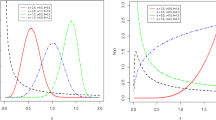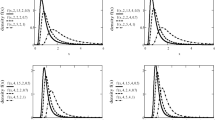Abstract
In this paper, we introduce a new useful continuous distribution called generalized modified inverse Weibull distribution. This distribution is a four-parameter extension of the modified inverse Weibull which generalizes some well-known distributions. Various statistical and probabilistic properties are derived such as rth moment, moment generating function, Renyi and Shannon entropies and hazard rate function. We also discuss estimation of the parameters by maximum likelihood and provide the information matrix. The likelihood ratio order (which implies the hazard rate and usual stochastic orders) between smallest order statistics from two independent heterogeneous samples of this new family are discussed. Finally, a real numerical example is also considered for illustrative purposes.
Similar content being viewed by others
References
Aarset, M. (1987). How to identify bathtub hazard rate. IEEE Trans. Reliab. 36, 106–108.
Aho, K., Derryberry, D. and Peterson, T. (2014). Model selection for ecologists: the world views of AIC and BIC. Ecology 95, 631–636.
Ang, A.H.S. and Tang, W.H. (1984). Probability Concepts in Engineering Planning and Design, vol. 2: Decision, Risk, and Reliability, 1st edn., Wiley, Language: English, ISBN-10: 0471032018, ISBN-13: 978-0471032014.
Aryal, G.R. and Tsokos, C.P. (2011). Transmuted weibull distribution: a generalization of the weibull probability distribution. Eur. J. Pure Appl. Math. 4, 2, 89–102.
Bebbington, M., Lai, C.D. and Zitikis, R. (2007). A flexible Weibull extension. Reliab. Eng. Syst. Saf. 92, 719–726.
Carrasco, J.M.F. and Ortega, M.M.E. (2008). A generalized modified Weibull distribution for lifetime modeling. Comput. Stat. Data Anal. 53, 450–462.
Chen, G. and Balakrishnan, N. (1995). A general purpose approximate goodness-of-fit test. J. Qual. Technol. 27, 154–161.
Corless, R.M., Gonnet, G.H., Hare, D.E.G., Jeffrey, D.J. and Knuth, D.E. (1996). On the lambert w function. Adv. Comput. Math. 5, 329–359.
Crooks, G.E. (2010). The Amoroso Distribution. arXiv:1005.3274 [math.ST].
Elbatal, I. and Muhammed, H.Z. (2014). Exponentiated generalized inverse Weibull distribution. Appl. Math. Sci. 8, 3997–4012.
Folks, J.L. and Chhikara, R. (1978). The inverse gaussian distribution and its statistical application-a review. Journal of the Royal Statistical Society B 40, 263–289.
James, V.D., James, R. and Holli, A. (2011). Fundamentals of mathematics. Brooks cole, language: english, ISBN-10: 0538497971, ISBN-13: 978-0538497978.
Johnson, N.L., Kotz, S. and Balakrishan, N. (1995). Continuous Univariate Distributions, 1, 2nd edn. Wiley, New York.
Khan, M.S. and Robert, K. (2012). Modified inverse weibull distribution. Journal of Statistics Applications and Probability 2, 115–132.
Khan, M.S., Pasha, G.R. and Pasha, A.H. (2008). Theoretical analysis of inverse Weibull distribution. Wseas Transactions on Mathematics 7, 1109–2769.
Khan, M.S., Robert, K. and Irene, L.H. (2014). Characterisations of the transmuted inverse Weibull distribution. Journal of the Australian Mathematical Society. Series B. Applied Mathematics 55, 197–217.
Keller, A.Z. and Kamath, A.R.R. (1982). Alternative reliability models for mechanical systems. In: Proceeding of the 3rd International Conference on Reliability and Maintainability, pp. 411–415.
Müller, A. and Stoyan, D. (2002). Comparison Methods for Stochastic Models and Risks. Wiley, New York.
Renyi, A. (1961). On measures of information and entropy. In: Proceedings of the fourth Berkeley Symposium on Mathematics, Statistics and Probability, pp. 547–561.
Shaked, M. and Shanthikumar, J.G. (2007). Stochastic Orders. Springer, New York.
Shannon, C.E. (1948). A mathematical theory of communication. Bell Syst. Tech. J. 27, 379–423.
Soliman, A., Amin, E.A. and Abd-El Aziz, A.A. (2010). Estimation and prediction from inverse Rayleigh distribution based on lower record values. Appl. Math. Sci. 4, 3057–4066.
Stanley, R.P. (2011). Enumerative Combinatorics, 1, 1st edn. Cambridge University Press, Cambridge. Language: English, ISBN-10: 1107602629, ISBN-13: 978-1107602625.
Author information
Authors and Affiliations
Corresponding author
Appendices
Appendix A: BesselK Function
by changing variable \((1-\exp (-\alpha /t))=x\), we have
by changing variable 1 − x = y, we have
where
Appendix B: Lagrange Inversion Formula
If F(x) is a series in x that satisfies the functional equation
Inverse of lagrange theorem (Stanley, 2011): If w is a power series with respect to x such that it is satisfies the following functional equation:
Then g(F(x)) has laurent series with the following coefficient:
Thus, we want to compute \(\frac {1}{F(x)}\), i.e., \(g(x)=\frac {1}{x}\) and F(x) = xexp(−F(x)). Therfore ϕ(x) = e−x. Then \([x^{n}] \frac {1}{F(x)}=\frac {1}{n}[y^{n-1}][\frac {-1}{y^{2}}e^{-ny}]\). But
The coefficient of yn− 1 in (10.1) is i − 2 = n − 1, i.e., i = n + 1 and finally
Appendix C: Differential
where
Rights and permissions
About this article
Cite this article
Saboori, H., Barmalzan, G. & Ayat, S.M. Generalized Modified Inverse Weibull Distribution: Its Properties and Applications. Sankhya B 82, 247–269 (2020). https://doi.org/10.1007/s13571-018-0182-1
Received:
Published:
Issue Date:
DOI: https://doi.org/10.1007/s13571-018-0182-1
Keywords
- Modified inverse Weibull distribution
- Generalized modified inverse Weibull distribution
- Hazard rate function
- Maximum likelihood estimation
- Order statistics
- Stochastic comparisons.




